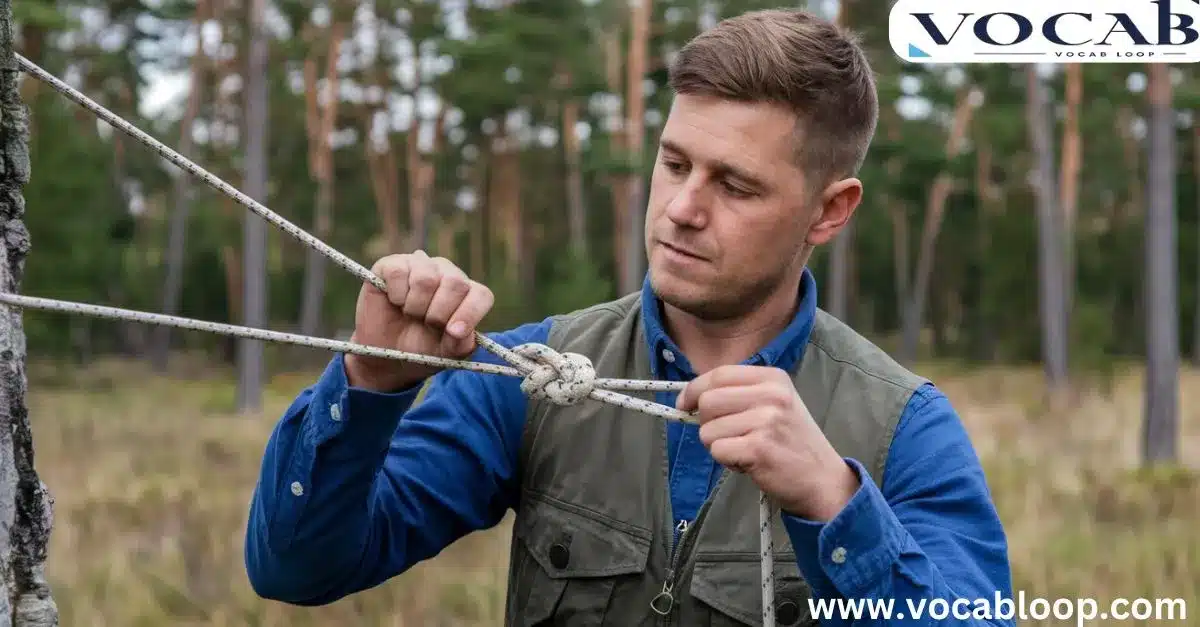When it comes to language details and correct form, understanding the difference between “tying” or “tieing” can significantly impact your writing quality. Many writers struggle with this common writing error. Whether they’re describing simple knot making or crafting professional documents.
This comprehensive usage guide will explore every aspect of these terms, from their definitions and proper usage to their origins and practical applications. By the end of this guide, you’ll have a clear understanding of which form to use in any context, helping you avoid confusion and maintain professional standards in your writing. Let’s unravel this linguistic knot together and master the correct usage once and for all.
Tying:

When we examine the word “tying,” we see the proper present participle of the verb tie in action. This form follows standard English rules and appears in all major dictionaries as the accepted version for describing actions involving shoelaces, knots, and bow tying.
Is tying a real word?
The answer is a resounding yes. Tying represents the standard form recognized by all English language authorities and style guides worldwide. This form appears consistently in professional writing, academic texts, and formal documents.
Definition:
Tying refers to the act of fastening, securing, or binding something using rope, string, or similar materials. This definition encompasses both literal and figurative uses of the term.
Meaning:
The meaning extends beyond simple knot creation to include concepts of connection, commitment, and completion. From securing physical objects to metaphorical expressions, tying conveys the idea of bringing things together securely.
Usage:
The term finds regular application in countless contexts, from practical instructions about shoelaces to metaphorical expressions about relationships. Proper usage always employs this spelling in formal writing.
Tieing:
As a variant spelling, tieing represents a common misspelling that appears occasionally in informal writing. This form, while understandable, doesn’t align with standard English spelling conventions.
Is tieing a correct word?
Despite its occasional appearance in older texts, tieing is not considered correct in modern English. Understanding spelling rules helps us recognize why this form has fallen out of favor in contemporary writing.
Definition:
While carrying the same intended meaning as tying, tieing represents a non-standard variant that dictionaries typically list as incorrect or obsolete. The form reflects a misunderstanding of English spelling rules.
Meaning:
The attempted meaning matches that of tying, but the incorrect spelling can distract readers and diminish the professionalism of your writing.
Usage:
Though sometimes seen in casual writing or social media posts, tieing should be avoided in any context where standard English is expected.
Side-by-Side Comparison
The detailed comparison below highlights key distinctions between these forms in modern English usage:
| Feature | Tying | Tieing |
| Grammatical Status | Standard form | Non-standard variant |
| Dictionary Recognition | Fully recognized | Generally unlisted |
| Professional Writing | Recommended | Discouraged |
| Academic Acceptance | Universal | None |
| Spell Check Response | Accepted | Flagged as error |
| Historical Usage | Consistent | Inconsistent |
| Modern Style Guides | Preferred | Not recommended |
| Global Recognition | Standard | Considered incorrect |
Which one is more acceptable?

The overwhelming consensus among language experts favors “tying” as the correct form in all contexts. This preference stems from consistent application of English spelling rules and widespread acceptance in professional writing.
Modern style guides and educational institutions worldwide recognize “tying” as the standard form. This acceptance makes it the clear choice for anyone concerned with writing accuracy and professional presentation.
Pronunciation of Tying and Tieing
The pronunciation remains identical for both spellings: /ˈtaɪɪŋ/, sounding like “TIE-ing” with emphasis on the first syllable. The differing spellings don’t affect how we say the word.
This consistency in pronunciation partly explains why the spelling confusion persists. Since both forms sound identical when spoken, writers sometimes struggle to remember which spelling follows standard rules.
Key Differences of Tying and Tieing
The primary distinction lies not in meaning or pronunciation but in acceptance and correctness. Understanding these differences helps writers make informed choices about which form to use in various contexts.
Professional writers and editors consistently choose “tying” because it follows standard English spelling patterns. This consistency helps maintain clarity in written communication and supports proper language clarity.
Tying or Tieing shoes

When discussing footwear, “tying shoes” represents the standard phrase used worldwide. This everyday action provides a perfect example of proper usage in practical contexts.
The phrase “tying shoes” appears in instruction manuals, educational materials, and everyday conversation. Its consistent use helps reinforce proper spelling patterns in practical applications.
Tying or Tieing in UK and US
Both British and American English unanimously prefer “tying.” This rare instance of complete agreement between these major English variants underscores the word’s correct form.
Neither variety of English accepts “tieing” as standard, making this one of the few spelling issues where no regional variation exists. This unity simplifies the choice for writers worldwide.
Synonyms of
Tying:
- Binding
- Fastening
- Securing
- Knotting
- Connecting
- Affixing
- Linking
- Attaching
- Mooring
- Anchoring
Tieing:
(Same synonyms apply, but remember this spelling is non-standard)
Origins of Tying or Tieing

1. Historical Origins
- Tie is derived from Old English tīegan, which itself came from the noun tīe or tēag, meaning a band or strap for fastening. Old Norse also had the similar word taug, which meant to tie or tether.
- Both tieing and tying were originally acceptable, but over time, “tying” became standardized in English usage.
2. The Spelling Shift
- English language conventions typically simplify verb forms when suffixes are added, such as tying for tie.
- Tieing kept the root word intact but was considered awkward, as the “e” doesn’t contribute to the pronunciation.
3. Modern Usage
- Tying: The standard form in modern English, meaning to bind or fasten something using a tie or knot.
- Tieing: Although it’s occasionally seen, it’s largely considered a misspelling today. However, it can sometimes appear in specialized contexts, like art or literature, where writers may prefer the alternate form for stylistic reasons.
Everyday Usage Examples
Tying Examples:
- “She’s tying her hiking boots before the trail.”
- “They’re tying decorations to the party balloons.”
- “He’s tying up the boat at the marina.”
- “We’re tying the packages securely for shipping.”
- “The chef is tying the herbs together.”
- “They’re tying the record for fastest completion.”
- “She’s tying back her hair before exercise.”
- “The climber is tying essential safety knots.”
- “We’re tying up loose ends before the deadline.”
- “He’s tying his tie for the interview.”
Tieing Examples (shown for reference as non-standard):
- “She’s tieing her shoelaces.” (incorrect)
- “They’re tieing ribbons on gifts.” (incorrect)
- “He’s tieing the rope to the post.” (incorrect)
- “We’re tieing everything together.” (incorrect)
- “The sailor is tieing knots.” (incorrect)
- “They’re tieing the score.” (incorrect)
- “She’s tieing her scarf.” (incorrect)
- “We’re tieing down the tarp.” (incorrect)
- “He’s tieing things up at work.” (incorrect)
- “They’re tieing the knot next month.” (incorrect)
Practical Application Tips: Avoiding Confusion with Tying and Tieing
Choosing the correct form of a word is crucial for maintaining professionalism and clarity in your writing. Here are practical tips to ensure you consistently use “tying” instead of the non-standard “tieing”:
- Learn the Rule for Words Ending in -ie
The spelling rule states that when forming the present participle of verbs ending in -ie, you replace the -ie with y before adding -ing.
For example:- Tie → Tying
- Die → Dying
This pattern is a helpful shortcut to remember correct spellings.
- Use Spell-Check Tools
Modern spell-checkers in writing software like Microsoft Word, Google Docs, or Grammarly will flag “tieing” as an error. Utilize these tools to automatically catch and correct such mistakes. Activate grammar enhancement features in these programs for additional context-sensitive corrections. - Practice with Common Scenarios
Familiarize yourself with phrases like:- Tying your shoes
- Tying loose ends
- Tying knots
- Tying a bow
Repeated use of correct examples in writing and speaking will make “tying” feel natural and intuitive.
- Visual Reminders
Create visual aids like flashcards with examples of correct usage. Write sentences such as:- “She is tying her scarf tightly.”
- “They are tying the packages with string.”
Place these cards in study areas or save them digitally for quick reference.
- Avoid Guessing When Unsure
If you’re uncertain about spelling, take a moment to look it up in a reliable dictionary or online resource. Searching for “present participle of tie” will quickly confirm that “tying” is the correct form. - Break Down the Word for Clarity
Think of “tying” as a fusion of the root word tie and the suffix -ing. If “tieing” looks awkward or visually off, it’s because it doesn’t conform to the standard structure of English words. - Use Mnemonics to Remember Correct Spelling
Mnemonics can be a helpful tool for memory. For example:- “Drop the ie and add a y, that’s how you tie properly.”
This rhyme can serve as a quick reminder in moments of doubt.
- “Drop the ie and add a y, that’s how you tie properly.”
- Exposure Through Reading and Writing
Regular exposure to correct English writing reinforces the habit of proper spelling. Read formal articles, instruction manuals, and professional materials that frequently use words like “tying.” - Peer Reviews and Feedback
When writing for important contexts, ask someone to proofread your work. A second set of eyes can catch errors like using “tieing” instead of “tying.” - Use Learning Apps
Apps like Quizlet, Duolingo, or other grammar-focused platforms can help reinforce spelling rules and correct forms like “tying.” Create or find lessons specifically addressing verb forms and participles.
FAQs
What’s the easiest way to remember the correct spelling?
Remember that ‘ie’ changes to ‘y’ before adding ‘ing’.
Can “tieing” ever be correct?
No, “tying” is always the correct form in modern English.
Why do people often misspell this word?
The confusion comes from uncertainty about handling ‘ie’ endings.
Does the meaning change between spellings?
No, both forms attempt to convey the same meaning.
Should I correct others who use “tieing”?
In professional contexts, gentle correction helps maintain standards.
Conclusion
The distinction between “tying” and “tieing” represents an important step in developing strong writing skills and achieving language clarity. Remember that “tying” is always the correct form, following proper spelling rules and maintaining linguistic correctness.
Whether you’re writing professionally or casually, choosing the right spelling demonstrates attention to detail and language proficiency. By understanding and applying these language rules, you’ve added another valuable tool to your writing arsenal, ensuring clearer, more effective communication in all contexts.

Alex Hormozi is a seasoned blogger at Vocab Loop, known for his deep insights into language, vocabulary, and grammar. With years of experience in writing, Alex shares practical tips and effective strategies to help readers improve their linguistic skills and enhance their writing abilities.

